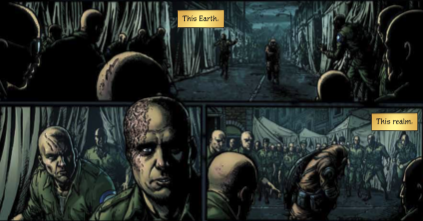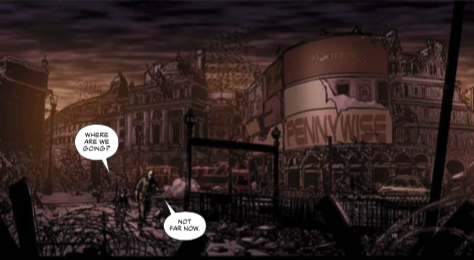Oliver #1 // Review
The past half century has been littered with some really great post-apocalyptic science fiction: Philip K. Dick’s novel Dr. Bloodmoney. Filmmaker George Miller’s Mad Max series. Black Isle Studios’ original Fallout games. There’s so much impressive work that’s already been done “after the bomb.” The history of the genre is all well and good, but what happens when nuclear apocalypse is mixed with a great literary classic by Charles Dickens? It’s a question that possibly NO ONE HAS EVER ASKED. Nevertheless English-born American screenwriter Gary Whitta is ready to provide answers as he presents Oliver: a twist on Dickens classic with art by Darick Robertson. Color comes to the page courtesy of Argentine artist Diego Rodriguez.
The first issue of the series establishes a dark world of post-apocalyptic London. A nuclear war has come and gone. London-based survivors of the war are clones manufactured to fight and survive it. The war is over, but it never really ended. No one won. Everyone simply stopped fighting. Into this world we find an orphan boy born of an actual mother being raised by surviving clones. He is named Oliver. In the opening issue, he’s let in on the story of his past, but there are things he isn’t being told.
There are mysteries in Whitta’s world that may prove to be interesting as the series progresses, but the initial trudge into a post-apocalyptic Charles Dickens feels a bit stiff. Fusing a 19th century London with a post-apocalyptic world is going to take a lot of work. The initial entry into that world feels rather unpleasantly disorienting. It doesn’t feel right quite yet. More world-building needs to be unearthed in order for a world of street urchins in post-apocalyptic London to feel natural. The characters themselves seem somewhat interesting. The bald eye-patched leader Prospero seems like he might develop into a complex post-apocalyptic patriarch.There’s some interesting conflict growing between him an apparent scar-faced rival.
Robertson’s art is dark, brutal and earthbound. It doesn’t seem to be drawn so much as blasted onto the page with a heavy industrial force. The effect is not without its charm, but action feels stiff and weighty. Drama does as well. Robertson works with impressive detail in places, but that detail is overwhelmed in places by great, ominous blocks of darkness. Rodriguez isn’t given a whole lot of space in which to deliver color and when he does, it’s really one hell of a lot of khaki and blue. Prospero’s black-and-white newsreel-style delivery of the war’s history is also cleverly rendered by Diego, but his greatest contributions to this issue are the murky mistiness in the backgrounds. The muted light of post-apocalyptic London is exquisitely atmospheric whether it’s the middle of the day or the middle of night.
As strange a mash-up as Whitta’s Oliver is, there’s real potential here for deep social commentary. The difficulty may lie in the novel that Whitta’s drawing-on for inspiration. Oliver. Twist looked to cast light on the sinister nature of child labor and children being ushered into shadowy streets to become criminals. It was a situation brought about by economic disparity. After the war, though...there IS no economic disparity. EVERYONE is living through irradiated hell. Without the presence of wealth, Whitta’s Oliver might well run the risk of missing a major component that made Dickens’ classic so important. This is, of course, early on in the series and there are many mysteries to be uncovered. And...sadly things haven’t entirely improved since Dickens’ time. There’s still injustice and exploitation in the modern world that Whitta could be covering with Oliver. There’s real potential for Whitta to make something great.










